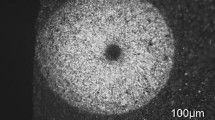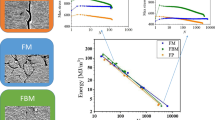Abstract
The very high cycle fatigue (VHCF) properties of case hardening steel 18CrNiMo7-6 after carburizing and pseudo-carburizing have been investigated by means of ultrasonic fatigue tests. Results showed that the pseudo-carburized specimens with the hardness of 442 HV did not show VHCF fracture, and fatigue fracture did not occur even after 109 cycles when the applied stress amplitude was lower than the high cycle fatigue limit of 650 MPa obtained at 107 cycles. When carburized thoroughly with the hardness of 700 HV, the experimental steel showed VHCF phenomenon, and it might fracture even at nearly 109 cycles when the stress amplitude was about 600 MPa. Observations of the fracture surfaces of the fatigue specimens showed that after carburizing, the fatigue crack initiation sites changed from martensite matrix to nonmetallic inclusions, forming granular bright facet (GBF) and fish-eye before final abrupt fracture. The stress intensity factor at GBF area, which was calculated to be 3.5 MPa m1/2, could be used as a critical value for VHCF fracture for the carburized specimens of the experimental steel. The VHCF fracture of the carburized specimens of the experimental steel could be related to the high hardness and large amount of retained austenite as a result of carburizing.










Similar content being viewed by others
References
T. Sakai, B. Lian, M. Takeda, K. Shiozawa, N. Oguma, Y. Ochi, M. Nakajima, and T. Nakamura, Statistical Duplex S–N Characteristics of High Carbon Chromium Bearing Steel in Rotating Bending in Very High Cycle Regime, Int. J. Fatigue, 2010, 32, p 497–504
W. Li, T. Sakai, M. Wakita, and S. Mimura, Influence of Microstructure and Surface Defect on Very High Cycle Fatigue Properties of Clean Spring Steel, Int. J. Fatigue, 2014, 60, p 48–56
Y. Furuya, Gigacycle Fatigue Properties of Double-Melted SCM440 Steel and Size Effects, ISIJ Int., 2014, 52, p 1436–1442
Z.G. Yang, S.X. Li, J.M. Zhang, J.F. Zhang, G.Y. Li, Z.B. Li, W.J. Hui, and Y.Q. Weng, The Fatigue Behaviors of Zero-Inclusion and Commercial 42CrMo Steels in the Super-Long Fatigue Life Regime, Acta Mater., 2004, 52, p 5235–5241
Y. Murakami, Metal Fatigue: Effect of Small Defects and Nonmetallic Inclusions, Elsevier, Oxford, 2002
T.D. Jeddi and T. Palin-Luc, A Review about the Effects of Structural and Operational Factors on the Gigacycle Fatigue of Steels, Fatigue Fract. Eng. Mater. Struct., 2018, 41, p 969–990
Y. Murakami, T. Nomoto, and T. Ueda, On the Mechanism of Fatigue Failure in the Superlong Life Regime (N > 107 Cycles). Part 1: Influence of Hydrogen Trapped by Inclusions, Fatigue Fract. Eng. Mater. Struct., 2010, 23, p 893–902
T. Naito, H. Ueda, and M. Kikuchi, Fatigue Behavior of Carburized Steel with Internal Oxides and Nonmartensitic Microstructure near the Surface, Metall. Mater. Trans. A, 1984, 15A, p 1431–1436
A. Nehila, W. Li, N. Gao, X. Xing, H. Zhao, P. Wang, and T. Sakai, Very High Cycle Fatigue of Surface Carburized CrNi Steel at Variable Stress Ratio: Failure Analysis and Life Prediction, Int. J. Fatigue, 2018, 111, p 112–123
G. Krauss, The Microstructure and Fracture of a Carburized Steel, Metall. Mater. Trans. A, 1978, 9, p 1527–1535
M. Erdogan and S. Tekeli, The Effect of Martensite Volume Fraction and Particle Size on the Tensile Properties of a Surface-Carburized AISI 8620 Steel with a Dual-Phase Core Microstructure, Mater. Charact., 2003, 49, p 445–454
Y. Liu, M.Q. Wang, J. Shi, W.J. Hui, G. Fan, and H. Dong, Fatigue Properties of Two Case Hardening Steels after Carburization, Int. J. Fatigue, 2009, 31, p 292–299
C.F. Wang, M.Q. Wang, J. Shi, W.J. Hui, and H. Dong, Effect of Microstructural Refinement on the Toughness of Low Carbon Martensitic Steel, Scr. Mater., 2008, 58, p 492–495
W. Chen, X.F. He, W.C. Yu, J. Shi, M.Q. Wang, and K.F. Yao, Nano- and Microhardness Distribution in the Carburized Case of Nb-Microalloyed Gear Steel, J. Mater. Eng. Perform., 2020, https://doi.org/10.1007/s1165-020-04992-7
S. Huang, G.Q. Zhang, M.Q. Wang, and H.L. Tan, Fatigue Properties of Heavy-Duty Gear Steel with Different Case Depth, J. Iron. Steel Res. Int., 2012, 24, p 34–48
G. Parrish, Carburizing: Microstructures and Properties, Heat Treat. Met., 1999, 27, p 2.
S. Roy and S. Sundararajan, The Effect of Heat Treatment Routes on the Retained Austenite and Tribomechanical Properties of Carburized AISI 8620 Steel, Surf. Coat. Technol., 2016, 308, p 236–243
E.C. Henry, C. O’Brien, and H.K. Yeddu, Multi-length Scale Modeling of Carburization, Martensitic Microstructure Evolution and Fatigue Properties of Steel Gears, J. Mater. Sci. Technol., 2020, 49, p 157–165
B. Wang, Y.Q. He, Y. Liu, Y. Tian, J.L. You, Z.D. Wang, and G.D. Wang, Materials, Mechanism of the Microstructural Evolution of 18Cr2Ni4WA Steel during Vacuum Low-Pressure Carburizing Heat Treatment and Its Effect on Case Hardness, Materials, 2020, 13, p 2352–2368. https://doi.org/10.3390/mal13102352
T. Sakai, N. Oguma, and A. Morikawa, Microscopic and Nanoscopic Observations of Metallurgical Structures Around Inclusions at Interior Crack Initiation Site for a Bearing Steel in Very High-Cycle Fatigue, Fatigue Fract. Eng. Mater. Struct., 2015, 38, p 1305–1314
Z.Q. Lei, Y.S. Hong, J. Xie, C.Q. Sun, and A.G. Zhao, Effects of Inclusion Size and Location on Very-High-Cycle Fatigue Behavior for High Strength Steels, J. Mater. Sci. Eng. A, 2012, 558, p 234–241
Y. Furuya, A New Model for Predicting the Gigacycle Fatigue Strength of High-Strength, J. Mater. Sci. Eng, 2019, 743, p 445–452
K. Shiozawa, Y. Morii, S. Nishino, and L. Lu, Subsurface Crack Initiation and Propagation Mechanism in High-Strength Steel in a Very High Cycle Fatigue Regime, Int. J. Fatigue, 2006, 28, p 1521–1532
K. Shiozawa, M. Murai, Y. Shimatani, and T. Yoshimoto, Transition of Fatigue Failure Mode of Ni-Cr-Mo Low-Alloy Steel in Very High Cycle Regime, Int. J. Fatigue, 2010, 32, p 541–550
Y.D. Li, N. Xu, H. Ma, and Y.Z. Li, Granular Bright Fact Crack Propagating under Very High Cycle Fatigue, Mater. Sci. Technol., 2016, 31, p 1894–1902
Author information
Authors and Affiliations
Corresponding author
Ethics declarations
Conflict of interest
The authors declare no conflict of interest.
Additional information
Publisher's Note
Springer Nature remains neutral with regard to jurisdictional claims in published maps and institutional affiliations.
Rights and permissions
About this article
Cite this article
Cheng, P., Li, Y., Yu, W. et al. Comparison of Very High Cycle Fatigue Properties of 18CrNiMo7-6 Steel after Carburizing and Pseudo-carburizing. J. of Materi Eng and Perform 29, 8340–8347 (2020). https://doi.org/10.1007/s11665-020-05257-z
Received:
Revised:
Accepted:
Published:
Issue Date:
DOI: https://doi.org/10.1007/s11665-020-05257-z




